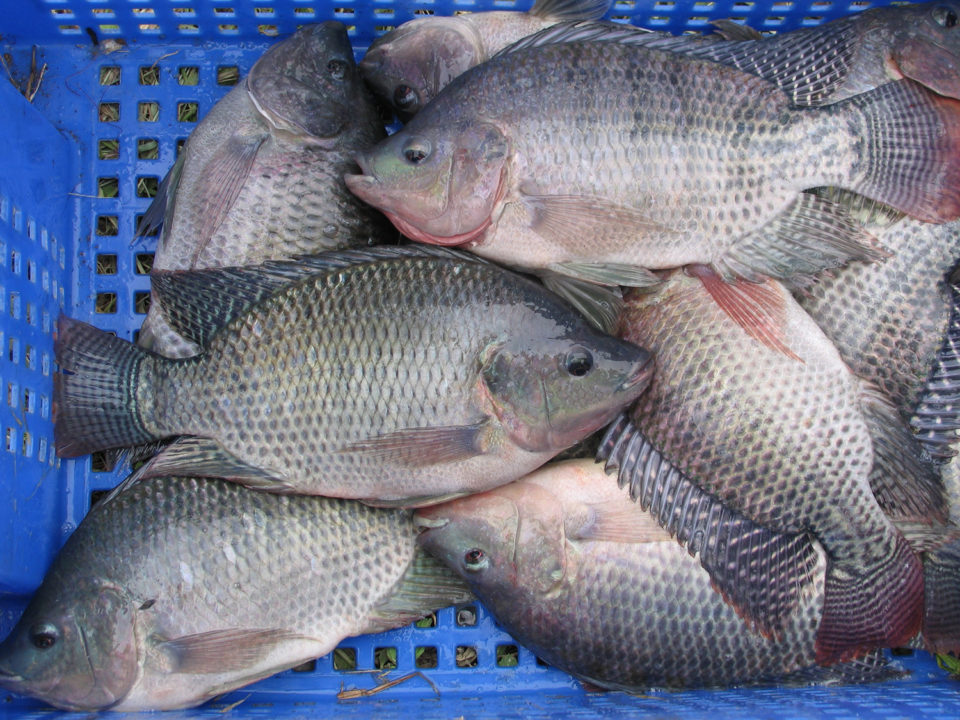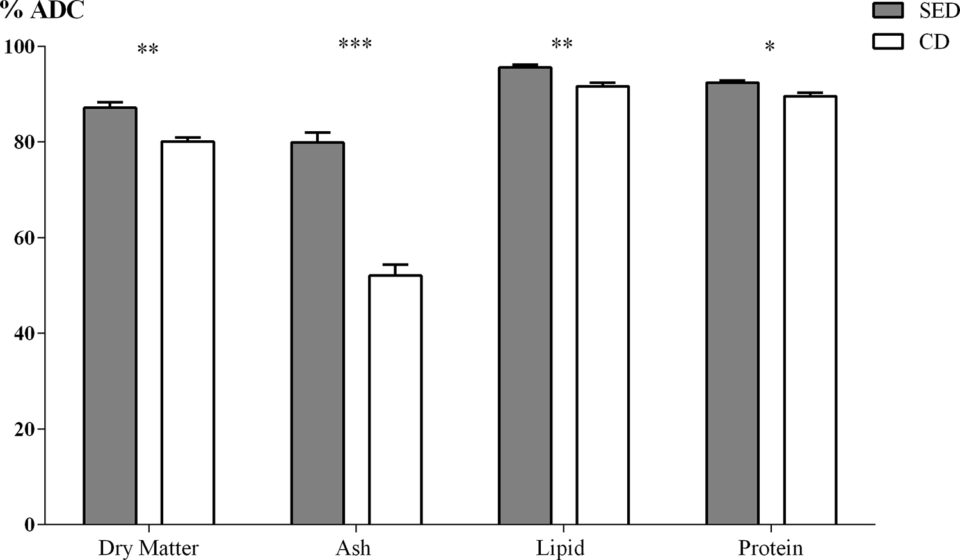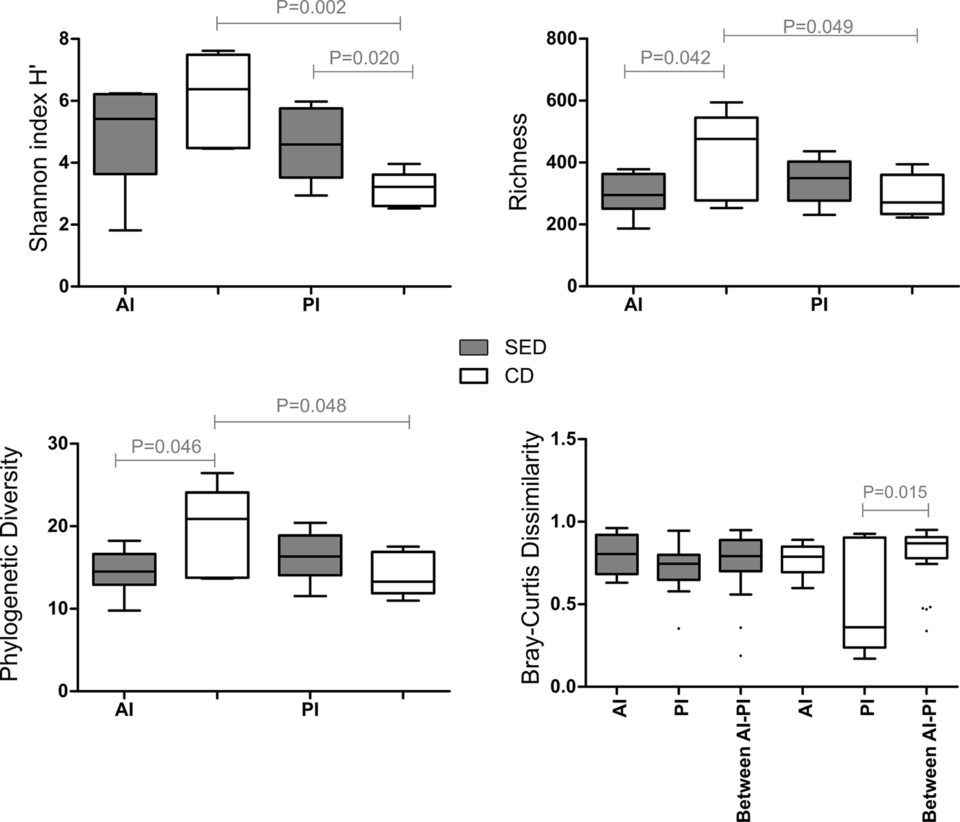Supplementation significantly increased digestibility of measured nutritional components

Several studies have shown that the addition of salt to fish feed has a significant impact on growth, feed utilization and physiological parameters in the intestine and blood. Studies aimed at understanding the specific effects caused by dietary salt supplementation found effects on both the basic intestinal enzymatic activity, and on the intestinal bacterial populations.
Sodium (Na+) has an important role in the intestinal absorption of numerous dietary nutrients, mediated by several transporters which have Na+/- dependent activity.
Protein digestion begins in the stomach and continues in the intestine, where it is broken down into free amino acids (FAA) or small peptides (short chains of amino acids linked by peptide bonds; di- and tri-peptides) by several proteases (enzymes that increase the rate of breakdown of proteins). Small peptides absorption is currently known to be mediated by one type of protein system in the intestinal brush borders, the Peptide Transporter (PepT). Little is known about the effect of dietary Na+ on intestinal nutrient absorption and on the relationships between the expression of PepTs and apparent digestibility coefficient (ADC) of proteins.
We hypothesized that the addition of sodium to fish feed will enhance the uptake of short peptides, resulting in higher protein digestibility. Nile tilapia (Oreochromis niloticus) is one of the world’s most widely cultured fish species, partially due to its ability to utilize a wide range of nutritional sources and suitability to various culture systems.
This article – adapted and summarized from the original – reports on a study to examine the impact of dietary salt (sodium chloride, NaCl) levels on nutrient absorption and PepTs expression in Nile tilapia. This research was supported by grants 356–5469 and 356–0672 from the Chief Scientist of the Ministry of Agriculture and Rural Development and grant IS-4800-15 from BARD. EH’s contribution to this research was part of his M.Sc. dissertation at Bar-Ilan University.
Study setup
The fish used in this study (8 months old, 125 ± 15 grams) were from the Chitralada strain of Nile tilapia, obtained from the Dor Aquaculture Research Station, Israel. Because tilapia aquaculture is based on all-male populations and to avoid sex-based variation, only male fish were used in this study.
Twelve fish were randomly distributed into conical shaped tanks, one fish per tank, with 12:12 hours light-dark photoperiod, and water temperature was kept at 25 ± 1 degrees-C. Levels of dissolved oxygen and pH were 6.54 ± 0.8 mg l-1 and 7.73 ± 0.46, respectively, throughout the experimental period. Ammonia and nitrite were measured once a week and were at non-detectable levels. The fish were acclimatized to the system for five days followed by a trial period of 42 days.
The experiment consisted of two treatments, six tanks in which the fish were fed with a salt-enriched (5 percent NaCl added) commercial diet (SED) and six tanks in which the fish were fed a regular commercial diet (CD). Fish were fed to satiation twice a day, and daily feed consumption was recorded for each fish. Prior to feeding, feces were collected and stored until analyzed. Fecal samples from each tank were pooled at the end of experiment. At the end of the trial, all fish were sacrificed and sampled. The fish intestine was removed, cleaned from remaining connective tissues and fat, and divided into three separate sections: anterior intestine, middle intestine and posterior intestine.
For detailed information on the experimental setup and samples collection; feces collection system; diet preparation; analytical methods; relative gene expression; intestinal microbiome analysis; and statistical analyses, refer to the original publication.
Results and discussion
Our results show that the addition of NaCl to the fish feed increases its digestibility. The apparent digestibility coefficient (ADC) values depend on the feed composition as well as the marker used and the fecal collection methods. Fish receiving the salt-enriched (SED) diet had higher growth parameters than the control, with specific growth rate (SGR) of 1.54 ± 0.1 compared to 1.13 ± 0.2 for the control, and daily weight gain of 2.78 ± 0.2 compared to 1.89 ± 0.4 for the control. They also had better FCR, 1.78 ± 0.1 compared to the 2.02 ± 0.3 of the control; however, these differences were not significant.
Fish that were fed the control (CD) diet excreted 9.7 percent more (dry feces) than the fish fed the SED: 0.271 ± 0.032 grams compared to 0.247 ± 0.018 grams (control) for one gram of body weight. The ADC for Nile tilapia of dry matter, ash, lipid and protein were significantly affected by the dietary treatment that had salt supplementation. The ADC of dry matter, ash, lipid and protein of the fish that were fed SED were significantly higher than for the fish fed the CD.

Better digestibility of dry matter leads to lower feces secretion to the water, thus causing less environmental pollution. In fact, per one gram of body weight, fish that were fed the CD excreted almost 10 percent more than the fish that were fed the SED.
In our study, the supplementation of NaCl to the feed improved protein digestibility in tilapia. Other authors have reported similar results in studies with rainbow trout (Oncorhynchus mykiss), with an effect of dietary NaCl on protein absorption although the mechanism behind this NaCl-dependent increase in protein utilization is not known. And research on Asian sea bass (Lates calcarifer) reported that the addition of salt to the feed enhanced the fishes’ activity of a proteolytic enzyme.
The involvement of the gut microflora in the processes of digestion and absorption of the host is widely recognized, including in fish. Factors such as diet composition are dominant in shaping gut microbial communities in both mammals and fish. However, there are very limited studies examining the effect of dietary salt in the levels on intestinal microbial communities. Our results show that dietary salt supplementation increased the microbial diversity in the posterior intestine, while at the same time made the microbial composition across the gut to become more similar, unlike the control fed fish where the microbial communities clearly discriminated by having higher diversity in the anterior and lower in the posterior intestine.

The increase of microbial diversity in the posterior intestine of the tilapia can also explain the positive correlation of the microbial diversity with lipids digestibility, as previously reported for other fish species. The exact mechanism of this improvement is not yet understood, but a potential change in the intestinal microbial balance could have accelerated food absorption.
Perspectives
The results of this study provide evidence that the addition of salt (NaCl) to the diet of Chitralada Nile tilapia increases the digestibility of protein, lipid, ash and dry matter. Results demonstrate that dietary NaCl content affects expression of PepT genes, although this is probably not the causative reason for the increased protein digestibility.
Further research is needed to characterize the relationship between dietary ions and nutrient transporters in the context of feed efficiency, and to better understand their connection with the gut microflora.
Now that you've finished reading the article ...
… we hope you’ll consider supporting our mission to document the evolution of the global aquaculture industry and share our vast network of contributors’ expansive knowledge every week.
By becoming a Global Seafood Alliance member, you’re ensuring that all of the pre-competitive work we do through member benefits, resources and events can continue. Individual membership costs just $50 a year. GSA individual and corporate members receive complimentary access to a series of GOAL virtual events beginning in April. Join now.
Not a GSA member? Join us.
Authors
-
Eyal Hallali, M.Sc.
Institute of Animal Science
Agricultural Research Organization
Rishon LeZion, Israel
Faculty of Life Sciences
Bar-Ilan University
Ramat-Gan, Israel -
Fotini Kokou, Ph.D.
Institute of Animal Science
Agricultural Research Organization
Rishon LeZion, Israel
Department of Life Sciences
Ben-Gurion University of the Negev
Beer-Sheva, Israel -
Tapan Kumar Chourasia, Ph.D.
Institute of Animal Science
Agricultural Research Organization
Rishon LeZion, Israel -
Tali Nitzan
Institute of Animal Science
Agricultural Research Organization
Rishon LeZion, Israel -
Pazit Con, M.Sc.
Institute of Animal Science
Agricultural Research Organization
Rishon LeZion, Israel -
Prof. Sheenan Harpaz
Institute of Animal Science
Agricultural Research Organization
Rishon LeZion, Israel -
Itzhak Mizrahi, Ph.D.
Department of Life Sciences
Ben-Gurion University of the Negev
Beer-Sheva, Israel -
Avner Cnaani, Ph.D.
Corresponding author
Institute of Animal Science
Agricultural Research Organization
Rishon LeZion, Israel
Tagged With
Related Posts

Aquafeeds
A look at phospholipids in aquafeeds
Phospholipids are the major constituents of cell membranes and are vital to the normal function of every cell and organ. The inclusion of phospholipids in aquafeeds ensures increased growth, better survival and stress resistance, and prevention of skeletal deformities of larval and juvenile stages of fish and shellfish species.

Intelligence
Assessing tilapia flour as an ingredient in bread
Six bread formulations with different levels of tilapia flour inclusion were analyzed for nutritional composition and sensory characterization.

Health & Welfare
Common salt a useful tool in aquaculture, part 1
The preventive use of common salt (sodium chloride) by commercial producers of freshwater fishes has many benefits, including helping with the routine prevention of losses due to diseases, stress and mishandling during transport, harvesting, grading, counting, weighing and induced spawning.

Health & Welfare
Organic acids in aquafeeds: A potential substitute for antibiotics
Prophylactic use of antibiotics in animal production is being banned or restricted by many countries. A potential substitute for antibiotic growth promoters in aquafeeds is organic acids, which are the focus of much research and commercial interest.


